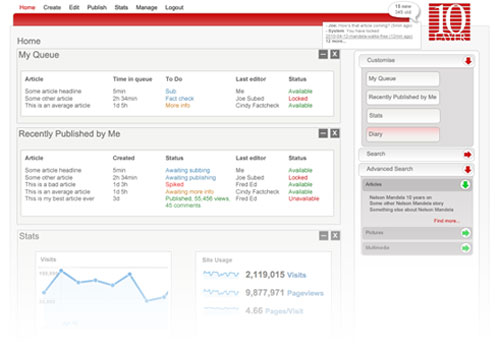
10Layer, the Johannesburg-based technology start-up building a publishing framework and content management system for online publishers, has landed a deal with the Mail & Guardian to power the weekly newspaper’s website.
Already, the company, started by Jason Norwood-Young, a former head of technology at the Mail & Guardian Online, is building the new publishing engine for current affairs website The Daily Maverick. It’s also helping it develop the technology behind iMaverick, its new iPad newspaper that is set to be launched soon.
Norwood-Young and his business partner Guy Taylor, who has been appointed as MD of 10Layer, are developing a publishing framework to help newsrooms publish content to the Web quickly and easily using defined workflows and processes. The system has been in development for the past nine months and Norwood-Young believes it’s ready for its first commercial implementation.
Norwood-Young says there is a gap in the market in that open-source options such as WordPress and Drupal aren’t necessarily tailored for high-end newspaper publishing environments without extensive customisation, while commercial options like Vignette are very expensive. He told TechCentral last year that one of his aims with 10Layer is to “commoditise high-end content management systems and show the larger players that they won’t be able to charge a fortune for these systems anymore”.

“We’re not trying to take on Drupal and WordPress, which do everything,” he says. “We’re trying to be niche.”
10Layer is aimed specifically at publishers and is a framework rather than a completely developed content management system, he explains. “We felt the type of publishers we’d be selling to would want to differentiate their platforms, so that’s why we built a framework. We built 90% of what all content management systems are based on, the last 10% being customisation [by the publisher].”
The system handles versioning, workflow and allows different gatekeepers in a newsroom to perform different roles simultaneously.
Built using object-orientated design principles, the system allows publishers to establish content types such as articles, photos, authors, multimedia items, galleries, and so on. “You can say this article relates to these photographs in this way and these authors in that way,” says Norwood-Young. “Each publication can specify at a very granular level what those content types are and how they interrelate.”
His partner, Taylor, says the software provides a newsroom-orientated workflow, with the ability to send content to different devices and applications — to iPad, for example, or to Twitter or Facebook. It also records all changes made to text and other content to retain tight control over the publishing process. It also allows for separate roles and permissions, allowing different people in the newsroom varying levels of access, and will provide links to newswire feeds to speed up the processing and posting of content.

10Layer is making its software available using three business models. The first involves a publisher buying the product in the traditional software licensing model sense. The second is a software-as-a-service option, where publishers subscribe to use the content management system and publication framework. The third involves a publisher outsourcing all their technology requirements to 10Layer, meaning all they have to worry about is generating content. Finally, there’s consulting revenue that can be earned around implementing the framework.
The software, which is being made available under an open-source licence, will be free for non-commercial use and for evaluation purposes. However, anyone making money using it is expected to pay.
“The code will be freely available, so people can tinker with it, change it, and so on,” says Norwood-Young. “It’s a blended open-source and commercial licensing model.” — Duncan McLeod, TechCentral
- Subscribe to our free daily newsletter
- Follow us on Twitter or on Facebook



